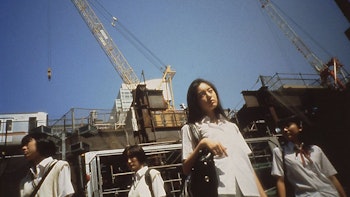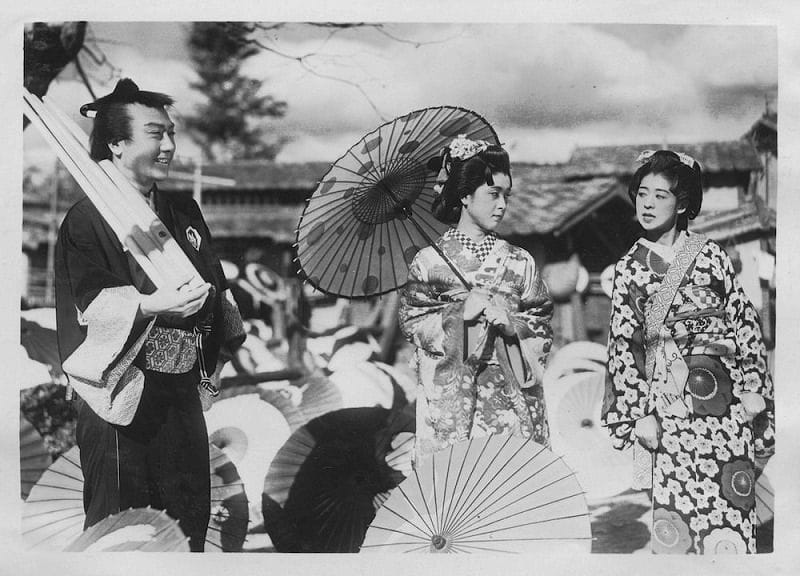
Disaster! It’s 1939, and a key actor has fallen ill with appendicitis, putting production on Masahiro Makino’s new film into limbo. The sets for his latest jidaigeki film are ready, and a full cast including a 24-year-old Takeshi Shimura, best known for starring in 21 Akira Kurosawa films including as the lead in Seven Samurai, have already gathered ready to shoot. Yet, production is now at a standstill. What can be done? Shoot another film concocted almost overnight in under two weeks. And make it a musical!
Singing Lovebirds is set in Edo-era Japan and centers a young woman named Oharu, the daughter of ronin Kyosai Shimura, who nowadays runs a store selling parasols. Such a store would likely offer a modest life for the pair, were it not for Kyosai’s obsession with antiques, a hobby that leaves him spending the little money they have on often-fake rarities of the past. One particularly-expensive fake leaves him deeply in debt to Lord Minezawa Tanba no Kami, leaving him with the prospect of having to sell his own daughter into marriage in order to pay it all off.
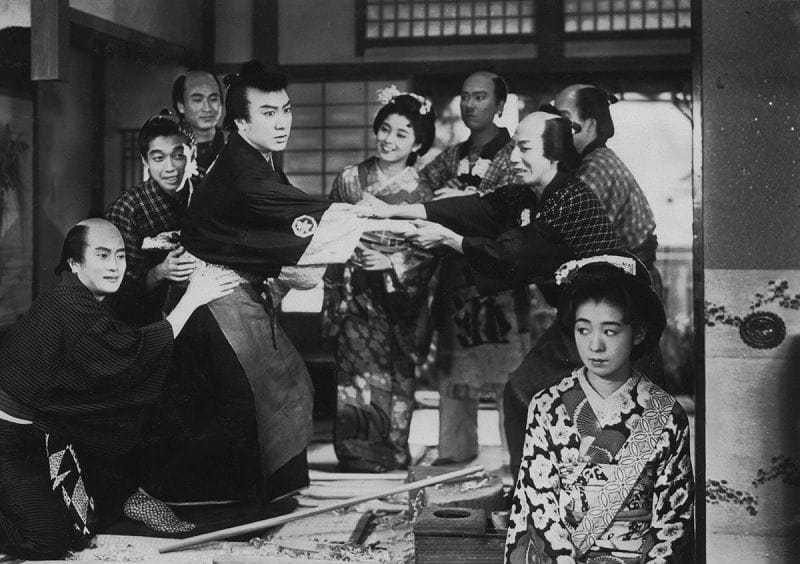
It’s a unique film, particularly for the era. Japan was only beginning to embrace talking films over a decade since Hollywood’s near-overnight replacement of silent films following the success of 1927’s The Jazz Singer, a delay caused in part by the popularity of benshi. These were narrators who would perform alongside silent films to act lines and interject commentary and comedy. These were performers in their own right, many possessing their own fans and bringing a unique experience, ensuring a slower tradition away from silent films in the country.
Even then, Japan wasn’t (and still isn’t), a country for movie musicals, with only a few more recent standout examples like Dance With Me even being made within a domestic landscape otherwise devoid of the genre, despite the proliferation of original musicals and a love for films about or inspired by music.
Yet that’s precisely what makes Singing Lovebirds so impressive and worthy of the time of anyone with a passing interest in Japanese movie history.
Nowadays, not only is this mostly-unplanned production the director’s most well-known work, but one of his some-200 pre-war films to survive when much of this era’s film’s have otherwise been lost to time. It’s even been remade for the stage, with the all-female Takarazuka Revue adapting the film featuring many of the songs plus new ones - their musical adaptation stands at 95 minutes, 25 minutes longer than the film’s 70 minute runtime.
The film was conceived and shot in an impressively-brief period of time to fill this newfound production gap in a time when staff already had access to the necessary sets. Pre-production including writing an entire script from scratch, and the creation of musical numbers for the film, a mix of jazz and traditional shamisen-accompanied spoken music known as joruri inspired by traditional theater, was completed in just four days. The whole film was shot in roughly a week, giving the film an impressively short production even compared to the typically quick-fire productions of the era.
While mostly lighthearted, it’s no less engaging for this quick turnaround, with sharp tongue-in-cheek commentary of gender roles, feudal power and its links to money. Takeshi Shimura, otherwise known for his more solemn and serious roles in grander productions, gets a chance to show a humorous side of himself as a bumbling and somewhat stupid businessman, and remains likable thanks to a suave singing voice and a sympathetic framing that places him more as an exploited man seeking purpose after life as a samurai.
The film is split almost neatly in two between a traditional love story between Oharu (Haruyo Ichikawa) and Asai Reisaburo (Chiezo Kataoka) - the ronin-next-door, so to speak - and this story involving Kyosai as he ponders selling his daughter to the lord in order to claw his way out of debt. They overlap, but their messages for audiences on the era they’re set and the webs of power are no less striking.
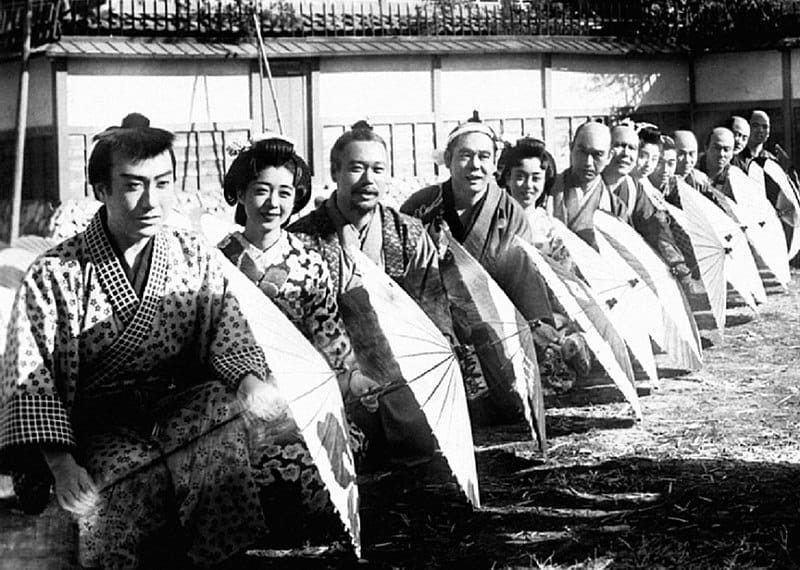
In the case of Oharu, it’s a lack of autonomy, trapped between love and family expectations, that manifests in humorous yet profound moments of anger. One of the film’s best musical moments comes in an almost petty joruri song between her and Otomi, another woman in love with Asai. The opening of the film sees Otomi turning down a flurry of pursuers before arriving at the parasol store. After she finishes flirting with Asai not long after Oharu’s breezy conversation with her crush, she wishes to purchase a parasol only to be denied by a jealous Oharu. The song descends into a humorous quarrel that leaves it impossible not to laugh just as strongly as Asai does as he leaves the two to their squabble.
Kyosai’s struggles feel resonant, particularly if we return to the era of the film’s release in a Japan wrapped amidst the throes of imperialism and on the cusp of further war beyond their ongoing East Asian expansionism. As he sinks into debt and contemplates ways to make his money back, power is wrestled both from Oharu and Kyosai thanks to their debt. Oharu’s true love may be ripped away as she is forced into wedlock, while Kyosai loses his autonomy due to the monetary control the lord now has over him. Who actually wields control, and who has to move at the whims of the powerful? “Some people use parasols, and others make them.”
That’s not to say the film is overly weighed down by broader thematic consequence, or that it’s even the most coherent at combining its various entertaining musical moments and ideas into a satisfying whole. The truncated production can be felt heavily in this film, with the storylines of Kyosai and Oharu feeling distant despite their blood relation and direct impact on one another. For all the music’s strengths, particularly in the finale (it certainly helps that the lord is played by a musician of the time in Dick Mine and everyone performs with surprising vocal strength that gives the narrative an intensity and momentum unusual for the period), the film can often descend into feeling like a collection of scenes and songs rather than a complete whole.
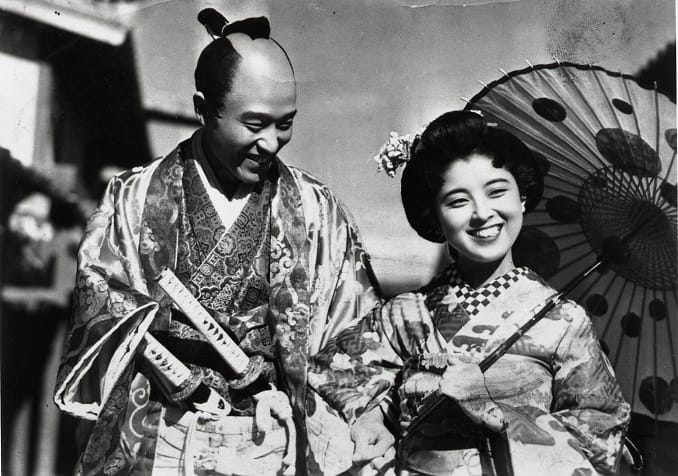
Yet it’s this music that makes it so fun. These songs are not only catchy and memorable, they're performed by actors who appear and sound visible relaxed by the free flowing nature of the film’s production. This was a chance to have fun, and the expressiveness of actors exaggerating their personas for comedic effect coupled with sharp dialogue and lyrics ensure plentiful laughs, even if some jokes will feel aged or inaccessible for many without deeper historical and cultural insight. It’s infectious, and it’s precisely this fun that allows for some of its more prescient ideas to come through.
It could be argued that the film needed a few more scenes to tie the otherwise-inconsequential love story and the more ‘important’ race to fix Kyosai’s debt problem together, but it is far from a dealbreaker when the film is entertaining in its own right. Besides, if you’re able to catch the recorded production of Singing Lovebirds from the Takarazuka Revue, the extended length of that production alongside its expanded cast fix exactly this issue. Each offers their own unique experience to the same story.
This is a milestone film unlike any other from this era, made only more impressive with an understanding of the unlikelihood and whirlwind production that brought it into existence. With early-career performances from some of the best Japanese actors ever to grace the screen, Singing Lovebirds is an under-seen gem just waiting to be rediscovered.
scrmbl's Classic Film Showcase shines a light on historical Japanese cinema. You can check out the full archive of the column over on Letterboxd.










